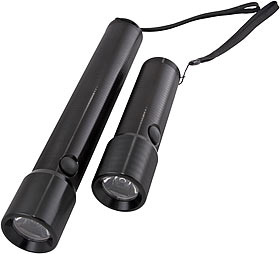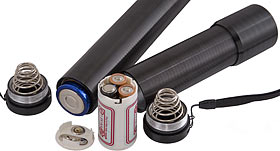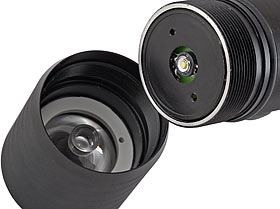
Quick Shot review 27:
Elektro Lumens Blaster 3P and Junior LED flashlights
Review date: 1st October 2005.
Last modified 03-Dec-2011.
When I reviewed Elektro Lumens' three-D-cell Blaster III flashlight a couple of years ago, I liked it a lot.
Unlike most LED flashlights, the Blaster had adjustable focus - narrow beam for possum-spotting, wide beam for seeing where you're going. And unlike most flashlights, LED or otherwise, the Blaster was very well made. Solid aluminium body with comfortable grip ridges, recessed front lens to avoid scratches, decent waterproofing, all for only $US70 plus shipping.
That's a lot to pay for a flashlight (well, by most people's standards...), but it was a good deal for a light of that quality. The only thing wrong with it was that the batteries rattled a bit. Not exactly a deal-breaker.
LED technology's moved on in the last couple of years, and so have the Blaster flashlights. They've gotten better, and they've gotten cheaper.
So, really, I could stop the review here and just tell you to go and buy one. But you might like a bit more guidance.
Here are two of the current Blaster models. The big one's the Blaster 3P; the little one's the Junior, or Jr.
The 3P looks very much like the earlier Blaster. The tail-cap with engraving that advertises Edison Electric as well as Elektro Lumens (apparently this deal didn't pan out, so the current tailcaps are Edison-free; the Edison Web site here has been down for rather a while), and a lanyard threaded through a hole. And the rubber-covered switch looks the same, but is now the Mag type that lets you partially press it for momentary operation (the old Blaster's switch didn't turn on until it clicked). And the 3P light is black rather than dark green. But apart from that, there's nothing new to see (or hear - the batteries still rattle. I suppose you could put paper around them or something, if you're worried about spoiling your ninja stealth).
The Blaster Jr is the same thing, abbreviated. The 3P is 287mm long (11.3 inches) and weighs about 825g (1.8 pounds) with alkaline batteries in it; the Jr is about 169mm long (6.65 inches) and weighs only 374 grams with batteries. It's still not really a pocket torch, because it's the same width as the D-cell-powered 3P, but the Jr is small and light enough to be readily portable in a briefcase, medium-sized purse or small backpack.
The Jr looks as if it runs from a single D cell, or might perhaps cram in two, but it actually...
...uses three AAs, in a holder that's not as hard to fill and close as you might think.
(If you think you might have to change the Junior's batteries in the dark, though, it might be an idea to buy another holder or two and carry them pre-loaded.)
Both of these Blasters have the same lamp - a white Lumileds Luxeon III, set up with Elektro Lumens' traditional overdriven power and matching heavy heat sinking.
The Luxeon III has a bigger die than the original one watt Luxeon (though not as big as the Luxeon V's), so the Fraen optic that gives the old Blaster such a narrow beam can't focus quite as tightly on the newer models. You get about a 12 degree bright-central-beam width at the tightest setting, with considerable dimmer spill around it. Wind the head out until its sealing O-ring lets go and the head starts wanting to separate from the flashlight, and you get about a 30 degree flood. There's a mild dark hole in the middle of the beam at full wide angle, but it's nothing compared with the rings and splodges of an ordinary adjustable incandescent flashlight beam.
You can, of course, unscrew the head entirely. Using one of these lights headless gives you a bit more than 180 degrees of light (because the LED stands above the surface of the end of the light), with a quite gentle brightness bias towards the centre. There's no beam at all, which is a very un-flashlight-ish experience. It's more like walking around with some elven Jewel of Luminance stuck to the palm of your hand, or something; the LED's more than bright enough to let you see everything in a large room, and everything casts satisfying point-source shadows. Plus, if you're outdoors, you'll, like, totally freak people out, dude.
In normal flashlight configuration, the two new Blasters are as much brighter as the old one - for a given beam width - as you'd expect. At their narrowest setting, the Blaster 3P peaked at an impressive 2600 lux at one metre from new batteries - but was, surprisingly, blown into the weeds by the Blaster Jr, which managed about 4350 lux at one metre if I aimed it just right - somewhere in the 3500 to 4000 lux range most of the time.
I wasn't expecting the light with the (much) smaller batteries to be brighter; I think the difference is attributable to the variation in Luxeon LED behaviour. The Blaster Jr I got for review also has a quite noticeably greenish beam compared with the regular LED blue-white of the 3P I got.
Apart from being less nice to look at, greener "white" light will score higher on a luxmeter than bluer light, because the lux is based on the lumen, which in turn is based on the standard candle, which is defined in terms of monochromatic light of wavelength 555 nanometres, which is in the middle of the green spectrum where the human eye is most sensitive.
So greener light doesn't actually get a higher brightness score than it deserves; all things being equal, it really does light up the world better from the point of view of a human being. Blue-white gives better colour rendering, though.
And when I say the Jr's output looks green, I don't mean it looks as green as ordinary cheap incandescent light looks yellow. Regular incandescents have very yellow output, even before their batteries start going flat; a "greenish" LED flashlight just gives mildly tinted light, which stays the same colour as the batteries sag.
Elektro Lumens, incidentally, put their arbitrary end-of-battery-life line for these two lights at 24 hours for the 3P running from NiMH rechargeables (which they recommend, though their high self-discharge and cliff-like discharge curve makes them a bad choice for emergency-light purposes) and eight for the Jr, whose little batteries not only have a lot less nominal capacity (two point something amp-hours for AAs, versus an easy twenty amp-hours for modern alkaline D cells), but also don't deal nearly as well with high discharge rates - so they go flat even faster than the nominal capacity figure suggests. The multi-watt load of an overdriven Luxeon III is a hard task even for D alkalines; the nine amp-hour NiMH D cells you can easily buy these days probably will deliver better results in a 3P, for everyday flashlight tasks (they'll set you back more than $US40 plus the price of a charger, though).
If you run either Blaster from alkalines, though, you will, as is normal for LED flashlights, get worthwhile output long after the batteries have given up most of their energy. That, and the fact that LED "bulbs" last a ludicrously long time if not severely abused, has made LED lights of all sorts favourites of people who run the risk of death or dismemberment if they unexpectedly find themselves in the dark.
Pleasant surprises
I saved the best for last: The current Blasters are quite a lot cheaper than the old ones.
The 3P and Jr have the same list price - $US49.99 plus shipping each, batteries not included.
As I write this, though, the 3P's on special for $US39.99, and the Jr's a buck cheaper.
Overall
Exactly what LED you get in your new-model Blaster would appear to be something of a lucky dip. I think I've got an unusually dim one in my 3P and a particularly bright - if green - one in my Junior.
The exact brightness of the lights, though, really doesn't matter much; we're talking about the difference between "very bright" and "extremely bright", by normal flashlight standards. And unless you've got a really dodgy Luxeon (which isn't at all likely; they sort their LEDs well, and the III is a mature product), you'll only notice the beam tint if you compare it with other LED lights.
At fifty US bucks a pop, these flashlights are great value. Discounted even further, they're a complete no-brainer. The 3P for battery life and, um, heft; the Jr for easier carrying (and I wouldn't like to be hit with it, either).
Highly recommended.
Review flashlights kindly provided by Elektro Lumens.
My review of the earlier Blaster is here.




